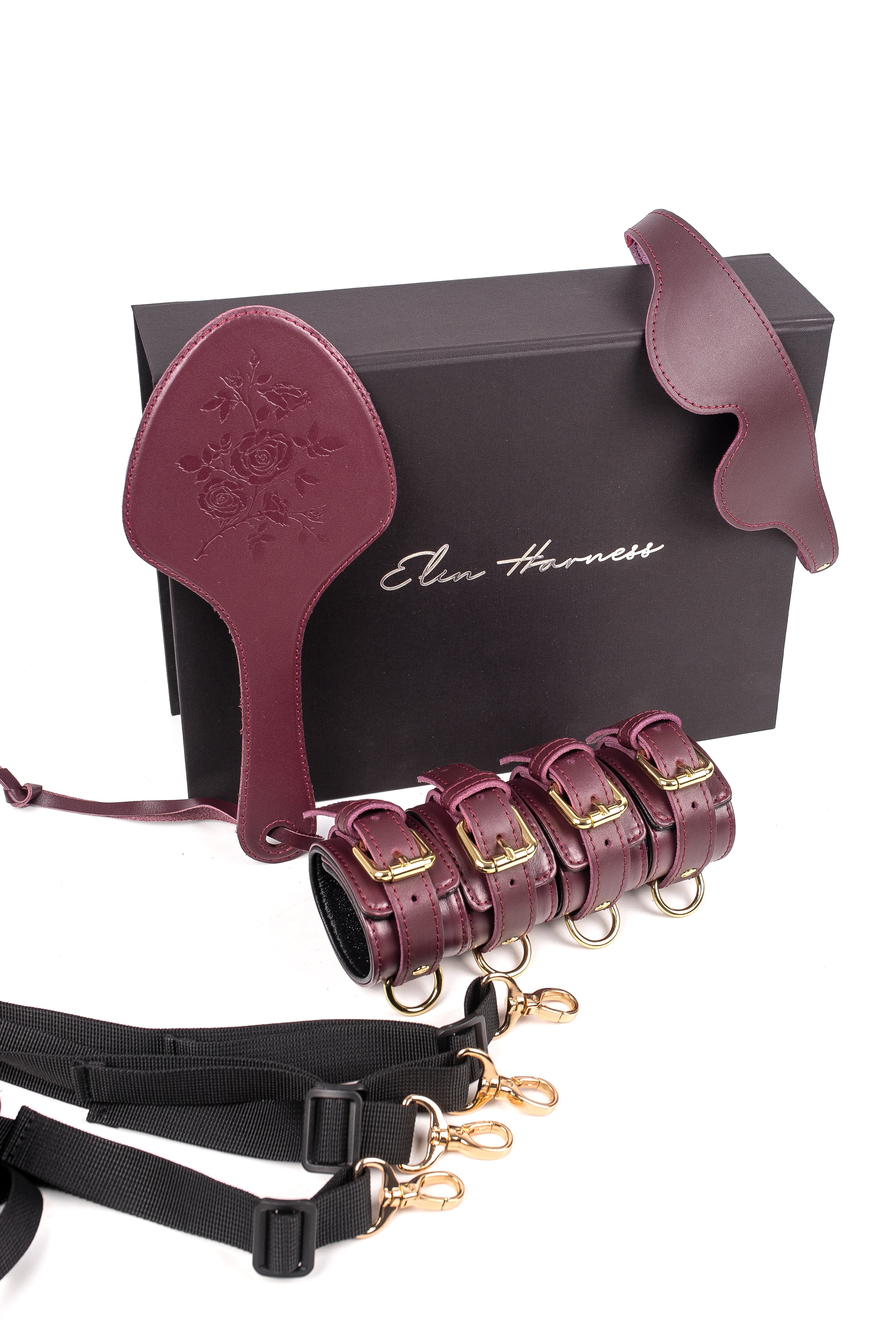Power exchange in dominant-submissive relationships is not about control or suffering as many people may think. It’s a consensual experience of both parties built on trust for the sake of connection, pleasure, and personal growth. In this article, we will learn more about what stands behind this mutual act of giving and receiving as well as explore the widespread stereotypes and misconceptions about power exchange.
What Is Power Exchange
Power exchange (or PE) is a type of consensual BDSM dynamic where one acts as a leader and the other is a follower. The most popular way to describe people in the follower and leader roles is dominant-submissive dynamics. Sometimes you can hear people call a dominant Daddy, Owner, Handler, Mommy, or Caregiver, while the sub may be called a Pet, Sub, Bottom, Servant, Baby, and others.
There can also be Masters and Slaves, who can represent roles in power-exchange roleplay and high-level relationships where more authority takes place.
You can also come across the mention of total power exchange where the leader takes control over all spheres of the sub’s life (their outfits, language, food, routine, and more).
Dom/Sub Dynamics Vs. Stereotypes
Similar to other spheres of our life, there are many stereotypes about power dynamics that often make people think about it as something bad or dangerous. However, once you dig deeper you can see that not everything is actually as you think, because power exchange is based on complex aspects of control, surrender, and mutual satisfaction.
Power exchange is not equivalent to abuse of power.
This is one of the most common misconceptions about BDSM dynamics. Unlike what many may think about it, the dom-sub dynamic doesn’t involve harm or abuse. Boundaries are clearly discussed before two participants start their power exchange dynamic. Each person clearly states their desires, physical limits, emotional thresholds, and activity restrictions. This is called setting the boundaries where they serve as guidelines to create a safe space.
Unlike abuse, where a person may search for ways to dominate and diminish, a healthy power exchange uplifts both participants, being built on a sense of trust and safety. All activities are chosen with the respect of the submissive’s limits and triggers. Moreover, some role-plays involve aftercare as well. Within a sexual hierarchy participants pay much attention to mutual understanding, not just domination. Moreover, the dom always stays responsible for the submissive’s well-being.
Although it’s true that BDSM dynamics may involve spanking, bondage, and all kinds of punishment, everything happens once the sub provides their consent.
It all starts with negotiating.
Negotiations are a significant part of power exchange dynamics aimed to help both parties feel safe and comfortable. This is where a sub states clearly their desires to help the dom understand what their partner is looking for mentally, emotionally and physically. They also negotiate about safewords or signals to reduce the risk of going over the top during scenes. Negotiations not only help doms figure out how to treat their subs but also help understand if they are compatible with potential partners.
Within the dom-sub dynamic the dom is not the only person who makes decisions.
There’s always a delicate balance as both participants create the scene and express their needs and limits beforehand.
Power exchange is not necessarily 24/7 dom-sub relationships.
There may be spheres of your life where you have some autonomy. You can still pick your clothes or make decisions by yourself. Total power exchange may be your distant goal, but for newcomers, such a dynamic can be too intense. It’s better to start slowly and try to act as a bottom in certain scenes that include elements of power exchange.
Total power exchange is not about abuse and extreme activities.
Within such a dynamic the dominant gets significant control over the submissive’s life. However, a healthy form of it always means fulfillment for both partners. Thus, total power exchange is more like trust, intention, and freedom that thrives on communication. Within such a dynamic, the person who is the sub doesn’t lose their independence.
Power exchange doesn’t mean extreme fantasies.
The BDSM form of intimacy attracts different people where some are interested in subtle sensations while others seek intense experiences. Everyone decides on what resonates with them.
Dominant-submissive relationships are about freedom from constant decision-making rather than limiting someone’s freedom. In everyday life, we all are overwhelmed by obligations and expectations. So once the sub agrees to follow a partner’s structured plan for an evening or a day, they can experience a rare sense of relief. They do not have to decide how to spend their time, what to eat and even what to wear. These relationships help them fully immerse themselves in the moment, enjoying the presence and emotional connection with the partner.
Moreover, the act of giving and receiving control over another person satisfies the natural human need for structure and defined roles. This is why submissive partners often experience a sense of calm when their dominants direct small tasks, choose outfits or build activity schedules for them. Within this dynamic, dominant partners also experience fulfillment through guiding and taking responsibility for their subs. For them, it’s about leading with strengths and care.
Power may extend into daily life beyond the bedroom.
People are not limited to enjoying only sexual interactions within the context of power exchange. A dominant might guide how chores are done in the household or set rules for shared routines (coffee rituals or evening check-ins). A submissive might show their commitment through performing small acts of service or following agreed-upon cues in conversation.
Types of Power Exchange
1. Total Power Exchange
The dominant controls every moment of the submissive’s life 24/7, including:
- The way the submissive speaks, dresses, or rests
- Check-ins and approvals for decisions
- Control over social and home life
2. Limited Power Exchange
This is a lighter version, where the dominant doesn't have an all-consuming control over the sub. The sub can still make decisions about work and finances while other aspects such as personal habits and sexual interaction remain under the dominant’s control.
3. Financial Domination
Within this dynamic, the dom takes full control over the submissive’s finances. They manage financial habits, provide or limit their access to bank accounts. This dynamic is mostly valued by individuals who would like to enjoy financial surrender or control.
Power Exchange Relationships: How They Actually Start
Most people have their own ideas about what they expect from power exchange. So it’s useful to start with exploring your desires. Make a mood board of what attracts you in power exchange, what it means to you. Or create a story where you can write down all your fantasies. Self-exploration helps you figure out your needs and what you look for in relationships. The better you know your desires the easier for your partner to treat you the way you can both find rewarding.
Some people like to be treated as pets, while others want to be Daddy’s girl. The best power dynamic is where you don’t lose yourself and your desires.
Conclusion
Despite many popular misconceptions, power exchange is built on trust, communication, and care. People who step into this world of relationships don’t seek domination for its own sake. They want some kind of fulfillment, where doms like to take on responsibilities and provide care for their subs, while subs search for freedom from obligations and decisions through structure provided by doms. Within power exchange, both parties are interested in satisfaction and emotional fulfillment through acts of giving and receiving.
Do you feel like this is for you and want to give it a try? Our shop offers a great variety of genuine leather restraints and lingerie to complement your power exchange dynamic no matter how intense it is.
As it’s a holiday time starting soon, make sure not to miss our tips on selecting Harness Gifts for Your Partner featuring a list of ideas for him and her.





Leave a comment
All comments are moderated before being published.
This site is protected by hCaptcha and the hCaptcha Privacy Policy and Terms of Service apply.